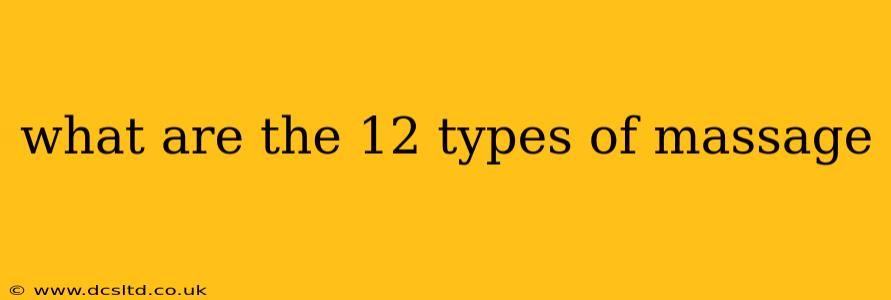The 12 Main Types of Massage Therapy: A Comprehensive Guide
Massage therapy offers a wide array of techniques, each designed to address specific needs and preferences. While there are numerous variations and blends, understanding the 12 main types provides a solid foundation for exploring the world of massage. This guide delves into each type, explaining its unique approach and benefits.
1. Swedish Massage: This is the most common type of massage, focusing on long, flowing strokes, kneading, and circular movements. It aims to relax muscles, increase circulation, and reduce stress. Swedish massage is often a good starting point for those new to massage therapy.
2. Deep Tissue Massage: As the name suggests, this type targets deeper layers of muscle and connective tissue. It uses slower, more intense pressure to release chronic muscle tension and knots. Deep tissue massage can be quite intense, and it's important to communicate your comfort level with the therapist.
3. Sports Massage: Designed specifically for athletes, this massage helps prevent injuries, improve performance, and aid in recovery after strenuous activity. Techniques include stretching, compression, and friction to address muscle soreness and tightness.
4. Trigger Point Massage: This focused technique targets specific points in the muscles called trigger points, which are often associated with pain and limited range of motion. Applying pressure to these points can relieve pain and restore muscle function.
5. Shiatsu Massage: Originating from Japan, Shiatsu uses finger pressure applied to specific points along energy pathways (meridians) in the body. It aims to balance the body's energy flow and promote relaxation and well-being.
6. Reflexology: This technique focuses on applying pressure to specific points on the feet (and sometimes hands) that correspond to different organs and systems in the body. It's believed to promote healing and balance by stimulating these reflex points.
7. Hot Stone Massage: This massage uses smooth, heated stones placed on the body to provide deep heat penetration and muscle relaxation. The warmth helps to relax muscles and improve circulation, making it particularly effective for relieving tension and muscle stiffness.
8. Prenatal Massage: Adapted for pregnant women, this massage uses gentle techniques to address common pregnancy-related discomforts, such as back pain, leg cramps, and swelling. Special considerations are taken to support the pregnant body and ensure comfort and safety.
9. Aromatherapy Massage: This massage incorporates essential oils into the massage, utilizing their therapeutic properties to enhance relaxation, reduce stress, and improve mood. The oils are selected based on individual needs and preferences.
10. Lymphatic Drainage Massage: This gentle massage technique promotes the movement of lymphatic fluid throughout the body, helping to detoxify and improve immune function. It's often used to reduce swelling and edema.
11. Myofascial Release: This technique focuses on releasing tension in the fascia, a connective tissue that surrounds muscles and organs. It uses gentle, sustained pressure to address restrictions and improve flexibility and range of motion. Often involves slow, sustained stretches.
12. Thai Massage: This ancient form of massage combines elements of yoga, acupressure, and meditation. It involves passive stretching and applying pressure to energy lines, promoting flexibility, relaxation, and improved energy flow. Often performed on a mat on the floor.
Frequently Asked Questions (FAQ)
What is the difference between Swedish and Deep Tissue Massage?
Swedish massage uses long, flowing strokes and is generally relaxing, while deep tissue massage utilizes slower, more intense pressure to target deeper muscle layers and release chronic tension.
Which type of massage is best for stress relief?
Swedish, aromatherapy, and hot stone massage are often recommended for stress relief due to their relaxing nature and ability to reduce muscle tension. Shiatsu can also be effective for stress reduction through energy balancing.
Is massage therapy safe for everyone?
While generally safe, massage therapy isn't suitable for everyone. Individuals with certain medical conditions, such as deep vein thrombosis or open wounds, should consult their doctor before receiving a massage. Always communicate any health concerns to your massage therapist.
This guide provides a starting point for understanding the diverse world of massage therapy. Remember to research individual types further and consult with a qualified massage therapist to determine the best approach for your specific needs and preferences. Finding a licensed and experienced therapist is crucial for ensuring a safe and effective massage experience.
